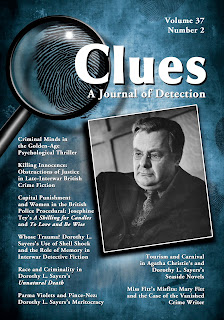Featuring History of Mystery/Detective Fiction and Other Literary Ramblings of Elizabeth Foxwell
Monday, September 02, 2019
Clues 37.2: Interwar mysteries.
The volume 37, no. 2 (2019) issue of Clues has been published, which is a theme issue on interwar mysteries guest edited by Victoria Stewart (University of Leicester, UK). See below for the abstracts. To order the issue, contact McFarland.
Ebook versions available: GooglePlay, Kindle, and Nook.
Introduction / VICTORIA STEWART. The guest editor of Clues 37.2 on interwar mysteries discusses its contents, including articles on Agatha Christie, Mary Fitt. Ngaio Marsh, Clifford Orr, Raymond Postgate, Dorothy L. Sayers, and Josephine Tey.
Detecting Histories, Detecting Genealogies: The Origins of Golden Age Detective Fiction / STACY GILLIS (University of Newcastle, UK). This article traces interwar attempts to define detective fiction, with an emphasis on how critics such as Dorothy L. Sayers, H. Douglas Thomson, and T. S. Eliot traced its origins in classical, biblical, and more recent texts. It argues that this demonstrates an anxiety relating to conceptions of literary taste on the part of these commentators.
“The Ghost of Dr. Freud Haunts Everything Today”:
Criminal Minds in the Golden-Age Psychological Thriller / STEFANO SERAFINI (Royal Holloway, University of London). This essay provides new insights into the development of interwar crime fiction by investigating how, and to what extent, two such apparently irreconcilable subgenres as the classic detective story and the psychological thriller interact and intertwine in the work of often-neglected Golden Age writers.
Killing Innocence: Obstructions of Justice in Late-Interwar British Crime Fiction / J. C. BERNTHAL (University of Cambridge). This article analyzes Agatha Christie’s And Then There Were None and Raymond Postgate’s Verdict of Twelve, both written toward the end of the interwar period and published at the outset of World War II. Christie and Postgate interrogate ethics in the British criminal justice system, using the figure of the child-victim to complicate interwar constructions of innocence.
Capital Punishment and Women in the British Police Procedural: Josephine Tey’s A Shilling for Candles and To Love and Be Wise / EVIE JEFFREY (University of Newcastle, UK). This article considers Josephine Tey’s engagement with contemporary capital punishment debates through considering the phenomenon of the “wrongful” arrest. It argues that women are central to the exploration of these debates, particularly when reading the novels as part of the subgenre of police procedurals within the Golden Age of detective fiction.
Whose Trauma? Dorothy L. Sayers’s Use of Shell Shock and the Role of Memory in Interwar Detective Fiction / KATHRYN HENDRICKSON (Marquette University). This essay places interwar understandings of shell shock in conversation with Dorothy L. Sayers’s Whose Body? (1923), arguing that Sayers utilizes the genre of detective fiction to revise cultural conceptions of shell shock as a marker of cowardice, situating it instead as a valuable reminder of the present’s continual connection to the past.
“His Appearance Is against Him”: Race and Criminality in Dorothy L. Sayers’s Unnatural Death / LAURA VORACHEK (University of Dayton). This essay places Dorothy L. Sayers’s novel Unnatural Death (1927) in the context of heightened xenophobia and racism in interwar Britain, arguing that Sayers attempts to challenge prevalent cultural associations of blackness and criminality. Like Wilkie Collins, Sayers works to critique and undermine racist assumptions and to generate sympathy for the colonial Other.
Parma Violets and Pince-Nez: Dorothy L. Sayers’s Meritocracy / MARY McGLYNN (Graduate Center and Baruch College, CUNY). In her Lord Peter Wimsey mysteries, Dorothy L. Sayers hastens the demise of the aristocracy, replacing it with a merit-based social order. This article traces the emergence of a new meritocracy via formal and thematic choices made by Sayers, including transliterated speech for upper-class characters, literary allusions, and hypergamy.
“I Always Did Hate Watering-Places”: Tourism and Carnival in Agatha Christie’s and Dorothy L. Sayers’s Seaside Novels / REBECCA MILLS (Bournemouth University, UK). This article examines the interwar watering-place in Agatha Christie’s Peril at End House (1932) and Dorothy L. Sayers’s Have His Carcase (1932), drawing on theories of tourism and the social history of coastal resorts to demonstrate how these authors subvert the recuperative leisure and pleasure of the seaside by revealing sites for hedonism, performance, and carnival.
“A Plan of Riddlesdale Lodge Was Handed to the Jury”: The Cartography of Crime in Golden Age Detective Fiction / ESME MISKIMMIN (University of Liverpool). Golden Age detective novels frequently feature maps of villages and plans of houses that enable the reader to visualize the terrain of the crime. This essay considers the purposes of maps in terms of navigation, location, and demarcation, as well as the subjective natures of their creation and interpretation.
Miss Fitt’s Misfits: Mary Fitt and the Case of the Vanished Crime Writer / NICK TURNER (University of Salford, UK). The Golden Age crime fiction of Mary Fitt (aka Kathleen Freeman) worked within generic rules yet was set in worlds where boundaries were broken, ambiguities remained beyond the closing pages, and the real truth could sometimes never be known. This essay examines why Fitt deserves re-examining through the lenses of form, structure, narration, and gender.
REVIEWS
Stephen Knight. Australian Crime Fiction: A 200-Year History. RACHEL SCHAFFER
Nils Clausson. Arthur Conan Doyle’s Art of Fiction: A Revaluation. DEBORAH LEITER
Elyssa Warkentin, ed. Short Stories by Marie Belloc Lowndes: A Monstrous Regiment of Women. VICTORIA STEWART
David Mason. Investigating Turkey: Detective Fiction and Turkish Nationalism, 1928–1945. ZEYNEP TÜFEKCIOGLU
Rachel Haliburton. The Ethical Detective: Moral Philosophy and Detective Fiction. CLAIRE MELDRUM
Lili Pâquet. Crime Fiction from a Professional Eye: Women Writers with Law Enforcement and Justice Experience. JENNIFER SCHNABEL
Clues index, volume 37
Subscribe to:
Post Comments (Atom)

No comments:
Post a Comment